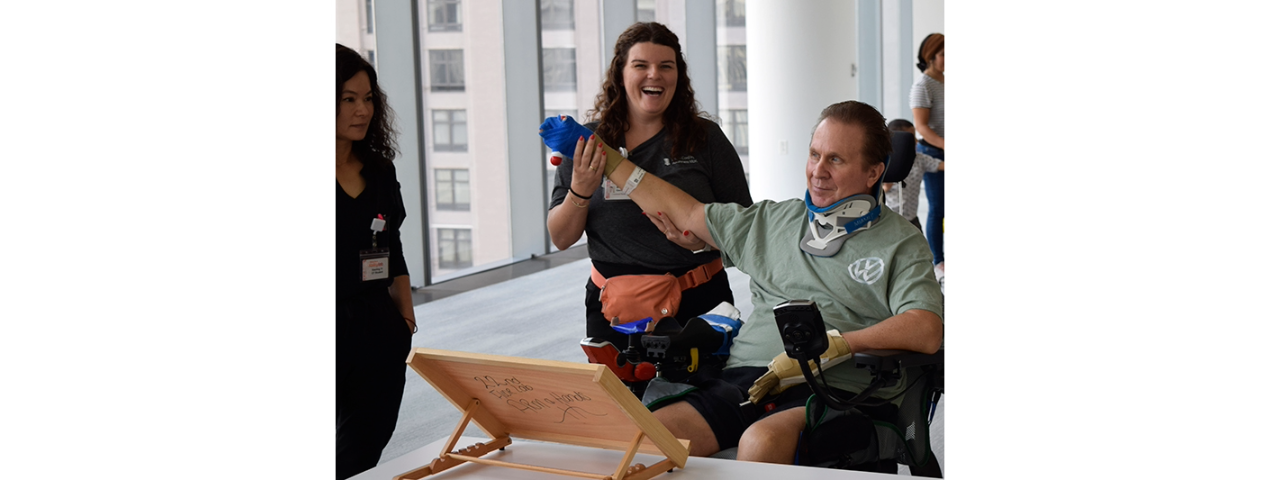Drug, Combined with Physical Therapy, has Potential to Unmask Stem Cell Potential
Body
The most common movement disorder in children, Cerebral Palsy (CP), affects approximately 750,000 people in the United States. Now, according to new research from the Shirley Ryan AbilityLab, published today in The American Journal of Physiology-Cell Physiology, a drug normally used to treat blood cancer also shows promise for treating muscle contractures in CP.
Unlike other neuromuscular conditions that are gene- or muscle-based, CP results from a brain injury or malformation that occurs while a child’s brain is still developing (e.g., before, during or immediately after birth). Debilitating muscle contractures caused by the hardening or shortening of muscles or other tissue are commonly associated with CP and lead to loss of movement.
“In an earlier study, we made the startling observation that the number of muscle stem cells in the contractured muscle of children with CP is significantly reduced,” said Richard L. Lieber, Ph.D., chief scientific officer at the Shirley Ryan AbilityLab and senior study author.
Mentioned Profile

Richard L. Lieber, PhD
Chief Scientific Officer & Senior Vice President of ResearchBody
“Satellite cells are the resident skeletal muscle stem cells, and are essential for the growth, repair and regeneration of muscle tissue after birth. Understanding that satellite cell number is prematurely depleted in kids with CP, we wanted to measure growth potential of these cells when isolated from contractured muscles to determine if they could grow new muscle tissue efficiently in vitro.”
As part of the study, Lieber’s team examined muscle biopsies acquired during pre-scheduled surgeries from both children with CP as well as from children without CP. Muscle satellite cells were isolated from these biopsies, expanded to a sizable number of cells, and then triggered to produce new muscle tissue in vitro.
Andrea Domenighetti, Ph.D., research scientist at the Shirley Ryan AbilityLab and lead study author, discovered that the capacity of satellite cells derived from contractured muscle to produce new muscle tissue in vitro was severely impaired. He and Lieber linked this impairment to DNA hypermethylation, an epigenetic imprint of the DNA that “switched off” genetic programs involved in producing new muscle tissue from satellite cells.
Mentioned Profile

Andrea Domenighetti, PhD
Research Scientist and Principal InvestigatorBody
The researchers identified a cancer drug, 5-Azacytidine (5-AZA), that helped to rescue the muscle growing capacity of in vitro satellite cells. After being treated with the drug, the cells grew new muscle tissue much better than did untreated satellite cells from children with CP. The team showed that a pretreatment with 5-AZA was sufficient to “wash off” the adverse epigenetic imprint and rescue the muscle-generating capacity of stem cells from contractured muscle.
Although further research and clinical trials will be needed, the researchers believe 5-AZA is a promising candidate to help relieve the deforming effect of muscle contractures in children with CP.
...we hope that pharmacological treatment with this class of drugs in combination with physical therapy may one day slow down, or even reverse, the progression of muscle contractures in CP.
Andrea Domenighetti, Ph.D.
Body
Marketed as Vidaza®, 5-AZA was approved by the U.S. Food and Drug Administration (FDA) in 2004 for the treatment of myelodysplastic syndromes, a type of cancer affecting blood-forming cells in the bone marrow. The drug acts to restore normal function of genes, thus restoring control over cell growth and maturation.
“In effect, 5-AZA seems to unmask the growth potential of stem cells in contractured muscle,” said Domenighetti. “More work needs to be done before the drug can be used therapeutically for patients with CP. However, we hope that pharmacological treatment with this class of drugs in combination with physical therapy may one day slow down, or even reverse, the progression of muscle contractures in CP.”
Applications could possibly include direct injections into areas of contracture or autologous stem cell therapy, which occurs when pre-treated stem cells are injected locally — or seeded on a transplantable stem cell-laden “patch” or scaffold — to treat contractures.
“Cancer has a strong clinical synergy with rehabilitation, and we’re poised to leverage the vast resources in cancer research to help our patients,” said Lieber. “This discovery could serve as the biological enabler of rehabilitation medicine and is the direct result of the translational approach we embrace at the Shirley Ryan AbilityLab, where doctors, scientists and therapists work hand-in-hand to solve patients’ biggest challenges.”
Body
Vidaza® is a registered trademark of Celgene Corporation.

